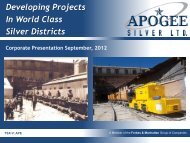Pulacayo Project Feasibility Study - Apogee Silver
Pulacayo Project Feasibility Study - Apogee Silver
Pulacayo Project Feasibility Study - Apogee Silver
You also want an ePaper? Increase the reach of your titles
YUMPU automatically turns print PDFs into web optimized ePapers that Google loves.
<strong>Pulacayo</strong> 1 000 t/d Phase I <strong>Feasibility</strong> <strong>Study</strong> - NI 43-101 Technical Report<br />
090644-3-0000-20-IFI-100<br />
country also contains sizeable reserves of natural gas that have not been fully developed to<br />
date, due to export issues and limited access to required infrastructure.<br />
Exploration in Bolivia by international companies has been minimal in recent years and<br />
Coeur d’Alene Mines Corporation (San Bartolome), Pan American <strong>Silver</strong> Ltd. (San Vicente),<br />
Glencore International plc (AR Zinc, Sinchi Wayra) and Apex <strong>Silver</strong> Mines Ltd - now Golden<br />
Minerals Company (San Cristóbal) have been the most significant international companies<br />
present in recent years. To a substantial degree, this reflects political instability and<br />
threatened changes to mining taxation. Basic exploration services are available in Bolivia<br />
and include several small diamond core drilling contractors, ALS Group, which operates a<br />
sample preparation facility in Oruro, SGS Group that has operations in La Paz, and several<br />
locally owned assay facilities.<br />
The Bolivian National School of Engineering operates a technical college in Oruro<br />
(Universidad Técnica de Oruro) that includes a mineral processing department and<br />
laboratory facilities that provide commercial services to the mining industry. In general, an<br />
adequate supply of junior to intermediate level geologists, metallurgists, mining engineers<br />
and chemists is currently considered to be present in the country.<br />
Approximately 600 people currently live in <strong>Pulacayo</strong> on a permanent basis and many are<br />
associated with the Cooperativa Minera <strong>Pulacayo</strong> Ltda. (<strong>Pulacayo</strong> Mining Cooperative). The<br />
village has a state-run school and medical services are provided by the state’s Caja<br />
Nacional de Seguros (National Insurance Fund). A hospital and clinic function<br />
independently. Numerous dwellings and mining related buildings in <strong>Pulacayo</strong> are owned by<br />
COMIBOL some of these have been donated to the <strong>Pulacayo</strong> Mining Cooperative. Under the<br />
Shared Risk Contract, COMIBOL makes some mining infrastructure available for use by<br />
<strong>Apogee</strong> (Figure 5.2).<br />
5.3.1 Utilities<br />
The country has an abundance of hydroelectric power and transmission lines, which parallel<br />
the road system, provide service to most major settlements. Remote villages generally have<br />
diesel generators, which run infrequently during evening hours. Transmission lines from the<br />
hydroelectric plants of Landara, Punutuma, and Yura that were reconditioned by a joint<br />
venture between COMIBOL and the Valle Hermoso Electrical Company and pass within a<br />
few km of <strong>Pulacayo</strong>.<br />
An adequate supply of potable water for the town is supplied by pipeline from a dam and<br />
reservoir (Yana Pollera) facility located 28 km from <strong>Pulacayo</strong> in the Cerro Cosuño.<br />
The project area lies between two climatic zones in the Andean region: the semi-humid Puna<br />
and the arid Puna. The wet season, when about 80% of the approximately 1.80 mm<br />
(average) annual precipitation occurs, is between December and March. Elevated wind<br />
velocity and solar radiation result in evapotranspiration rates of approximately 1,700 mm per<br />
year, of which the higher rates are encountered during the dry season of April to November.<br />
The discrepancy between magnitudes and seasonality of precipitation and evaporation result<br />
in a short period of excess water during the wet season, and water shortages during the dry<br />
season.<br />
TWP Sudamérica S.A. Av. Encalada 1257 Of. 801, Santiago de Surco Lima 33, Perú (51-1) 4377473<br />
Page 30



